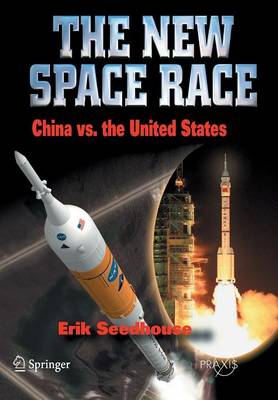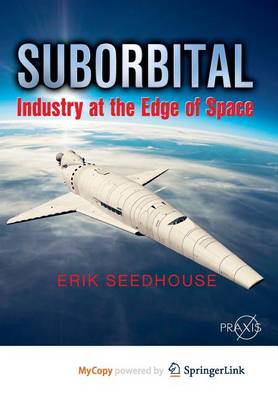Springer-Praxis Books in Space Exploration
5 total works
Lunar Outpost provides a detailed account of the various technologies, mission architectures, medical requirements and training needed to return humans to the Moon within the next decade. It focuses on the means by which a lunar outpost will be constructed and also addresses major topics such as the cost of the enterprise and the roles played by private companies and individual countries. The return of humans to the surface of the Moon will be critical to the exploration of the solar system. The various missions are not only in pursuit of scientific knowledge, but also looking to extend human civilization, economic expansion, and public engagement beyond Earth. As well as NASA, China's Project 921, Japan's Aerospace Exploration Agency, Russia, and the European Space Agency are all planning manned missions to the Moon and, eventually, to Mars. The Ares-I and Ares-V are the biggest rockets since the Saturn V and there is much state-of-the-art technology incorporated into the design of Orion, the spacecraft that will carry a crew of four astronauts to the Moon. Lunar Outpost also describes the human factors, communications, exploration activities, and life support constraints of the missions.
Mars Outpost provides a detailed insight into the various technologies, mission architectures, medical requirements, and training needed to send humans to Mars. It focuses on mission objectives and benefits, and the risks and complexities that are compounded when linked to an overall planet exploration program involving several expeditions and setting up a permanent presence on the surface.
The first section provides the background to sending a human mission to Mars. Analogies are made with early polar exploration and the expeditions of Shackleton, Amundsen, and Mawson. The interplanetary plans of the European Space Agency, NASA, and Russia are examined, including the possibility of one or more nations joining forces to send humans to Mars. Current mission architectures, such as NASA’s Constellation, ESA’s Aurora, and Ross Tierney’s DIRECT, are described and evaluated.
The next section looks at how humans will get to the Red Planet, beginning with the preparation of the crew. The author examines the various analogues to understand the problems Mars-bound astronauts will face. Additional chapters describe the transportation hardware necessary to launch 4-6 astronauts on an interplanetary trajectory to Mars, including the cutting edge engineering and design of life support systems required to protect crews for more than a year from the lethal radiation encountered in deep space. NASA’s current plan is to use standard chemical propulsion technology, but eventually Mars crews will take advantage of advanced propulsion concepts, such as the Variable Specific Impulse Magnetoplasma Rocket, ion drives and nuclear propulsion.
The interplanetary options for reaching Mars, as well as the major propulsive maneuvers required and the trajectories and energy requirements for manned and unmanned payloads, are reviewed . Another chapter addresses the daunting medical problems and available countermeasures for humans embarking on a mission to Mars: the insidious effects of radiation on the human body and the deleterious consequences of bone and muscle deconditioning. Crew selection will be considered, bearing in mind the strong possibility that they may not be able to return to Earth. Still another chapter describes the guidance, navigation, and control system architecture, as well as the lander design requirements and crew tasks and responsibilities required to touch down on the Red Planet.
Section 3 looks at the surface mission architectures. Seedhouse describes such problems as radiation, extreme temperatures, and construction challenges that will be encountered by colonists. He examines proposed concepts for transporting cargo and astronauts long distances across the Martian surface using magnetic levitation systems, permanent rail systems, and flying vehicles. In the penultimate chapter of the book, the author explains an adaptable and mobile exploration architecture that will enable long-term human exploration of Mars, perhaps making it the next space-based tourist location.
The world’s most populous nation views space as an asset, not only from a technological and commercial perspective but also from a political one. The repercussions of this ideology already extend far beyond Washington. China vs. the United States explores future Chinese aspirations in space and the implications of a looming space race.
Dr. Seedhouse provides background information on the fifteen-year history of the China National Space Administration and its long list of accomplishments. Sino-U.S. technological and commercial interests in space are discussed, including their interest in encouraging a potential space race. The national security objectives of the U.S. and China are also examined.
The nascent commercial suborbital spaceflight industry will soon open the space frontier to commercial astronauts, payload specialists, scientists and of course, tourists. This book describes the tantalizing science opportunities to be offered when suborbital trips become routine within the next 12 to 18 months. It describes the difference in training and qualification necessary to become either a spaceflight participant or a fully-fledged commercial suborbital astronaut and it describes the vehicles this new class of astronauts will use.
Anticipation is on the rise for the new crop of commercial suborbital spaceships that will serve the scientific and educational market. These reusable rocket-propelled vehicles are expected to offer quick, routine and affordable access to the edge of space along with the capability to carry research and educational crew members. Yet to be demonstrated is the hoped-for flight rates of suborbital vehicles.
Quick turnaround of these craft is central to realizing the profit-making potential of repeated sojourns to suborbital heights. As this book outlines, vehicle builders still face rigorous shake-out schedules, flight safety hurdles as well as extensive trial-runs of their respective craft before suborbital space jaunts become commonplace. The book examines some of these 'cash and carry' suborbital craft under development by such groups as Blue Origin, Masten Space Systems, Virgin Galactic and XCOR Aerospace and describes the hurdles the space industry is quickly overcoming en-route to the industry developing into a profitable economic entity.
Seedhouse also explains how the commercial suborbital spaceflight industry is planning and preparing for the challenges of marketing and financing and how it is marketing the hiring of astronauts. It examines the role of commercial operators as enablers accessing the suborbital frontier and how a partnership with governments and the private sector will eventually permanently integrate the free market's innovation of commercial suborbital space activities.




